The 2018 Prism Awards for Photonics Innovation brought out the best of the best. Many companies in Europe and others from around the world were among 30 finalists for the awards that recognize the industry’s top innovations and groundbreaking technology. This year’s awards shined a spotlight on 10 winners during the annual ceremony on Jan. 31.
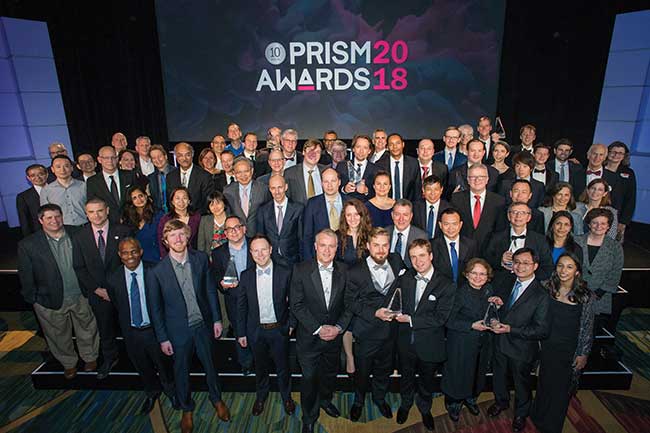
Winners of the 2018 Prism Awards for Photonics Innovation were chosen from a field of hundreds of innovators from around the world. Courtesy of SPIE.
“Each year, categories for the awards are driven by the innovations entered, providing direct insight into thriving and emerging ‘hot’ markets,” said SPIE CEO Eugene Arthurs.
Co-sponsored annually by SPIE and Photonics Media, the “Oscars of the photonics industry” marks its 10th year in 2018.
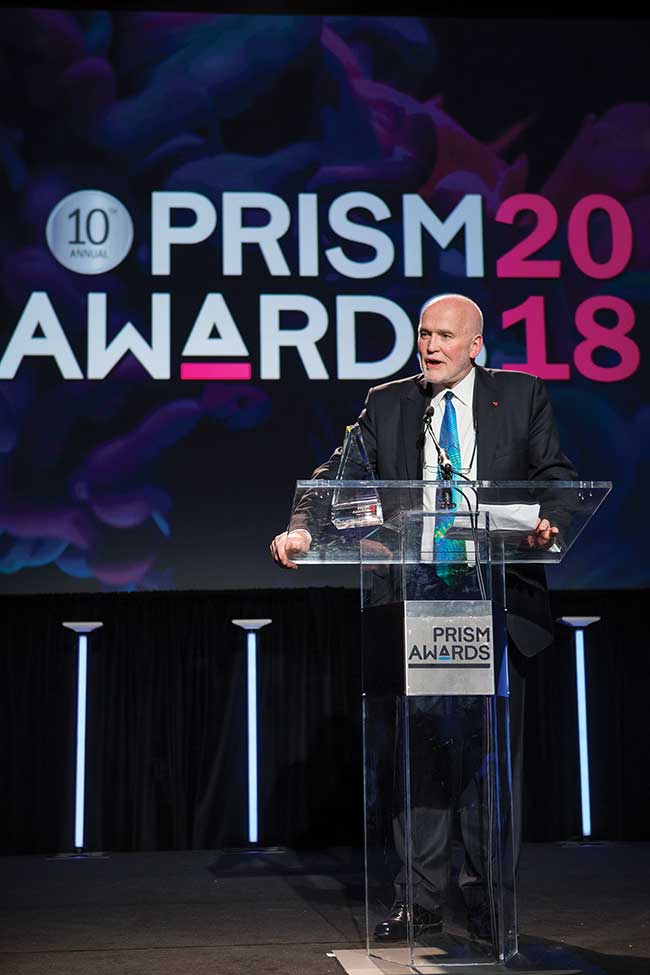
SPIE CEO Eugene Arthurs speaks to the importance of recognizing and fostering photonics innovation. Courtesy of SPIE.
“These Prism Award-winning products and the companies behind them have reached new heights of technical achievement and innovation and have risen to the top of an impressive field of entries,” said Thomas Laurin, president and CEO of Laurin Publishing. “Photonics Media is proud to have stood with SPIE and the Prism Awards for 10 years supporting breakthroughs such as these that continue to transform the photonics industry and the world. We extend our heartiest congratulations to the winners.”
DETECTORS AND SENSORS
NKT Photonics (Birkerød, Denmark)
A growing demand for efficient renewable-energy resources makes the management of power networks more complex. The LIOS EN.SURE DTS & RTTR — a long-range optical fiber-based temperature and strain-sensing measurement system — is designed for such management. It monitors underground transmission and distribution power cables, as well as overhead transmission lines. Using an optical fiber embedded in the power cable, or installed externally, the LIOS EN.SURE system is able to measure temperature and strain in the cable over single-ended distances of up to 70 km. It also can handle up to 16 fibers and 16 separate power cables, while its strain capability can be used to detect cable disturbance, abnormal bends and/or kinks in the cable before, during and after installation.
Class 5 Photonics (Hamburg, Germany)
At an industry-leading 1 mJ, 100 kHz and 100 W, the Supernova OPCPA performs 10× faster than conventional Ti:Sapphire lasers. It feautres extremely short pulse durations down to 15 fs and covers a broad wavelength range (from 0.4 to 3.0 μm). Wavelength flexibility allows tailoring to custom multicolor experiments at full system performance and stability. The Supernova OPCPA can be employed in research of attosecond science, materials processing and ultrafast spectroscopy.
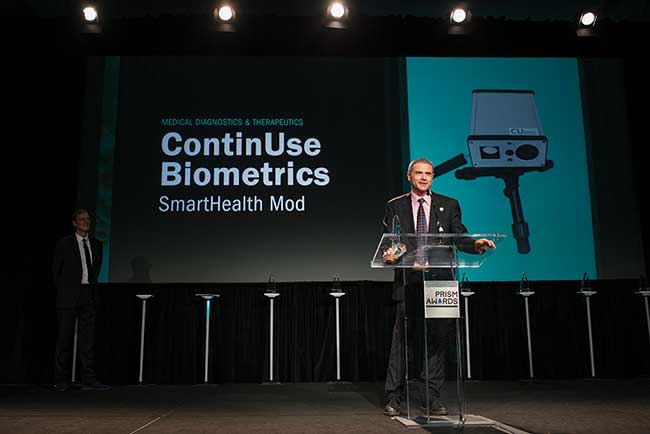
ContinUse Biometrics, from Tel Aviv, Israel, accepts the Prism Award in the Medical Diagnostics and Therapeutics category. Courtesy of SPIE.
MATERIALS PROCESSING AND ADDITIVE MANUFACTURING
LIMO GmbH (Dortmund, Germany)
The Activation Line UV-L750 is an optical beam delivery and beam shaping system designed for UV laser lift-off (LLO) of flexible OLED displays. Its optical beam transformation technology enables 10× larger depth-of-field for high-end lift-off processes in mass production tools for flexible OLEDs. It can combine up to 12 laser sources into one single-line beam profile and can also be used for LLO and solid-state laser annealing.
OPTICS AND OPTOMECHANICAL COMPONENTS
AdlOptica Optical Systems GmbH (Berlin)
The foXXus multifocus optics technology allows simultaneous multilayer materials processing for effective depth-of-field and controlled propagation of a processed zone such as cracks in glass and other brittle materials. With refractive design and lenses with polished optical surfaces, it is used in conjunction with lasers to redistribute energy along the optical axis (polarization energy splitting). FoXXus offers high resistance to CW and ultrashort-pulse lasers, providing up to eight separate foci.
ENVIRONMENTAL MONITORING
Block Engineering (Massachusetts, U.S.)
Using QCLs combined with mid-IR spectroscopy, the LaserWarn can quickly detect and identify chemical clouds. The system touts the widest tunable external-cavity, eye-safe lasers and scans across a 5- to 13-µm-wide spectral range in less than 40 ms. The system provides ultrarapid, subsecond response to chemical threats and monitoring of chemical releases. Its lasers can monitor chemical clouds across thousands of square feet, whether indoors or out. LaserWarn allows chemical analysis algorithms, as well, providing the ability to detect and identify components of high-number, multicomponent mixtures in real-world environments.
ILLUMINATION AND LIGHT SOURCES
SoraaLaser (California, U.S.)
Touted as the world’s first white-light, high-luminance, remotely delivered white laser light module, the LaserLight Fiber Module features the highest luminance light source available. It’s safe, high-efficiency fiber delivery of light from a blue laser diode to a remote phosphor module produces high-luminance, incoherent, broad-spectrum white light. This device enables lighting effects such as long-range, highly collimated beam output, as well as compact ultrashort throw, high angle illumination and glare-free pattern generation with sharp light gradients. It also includes active light level sensors for precise control.
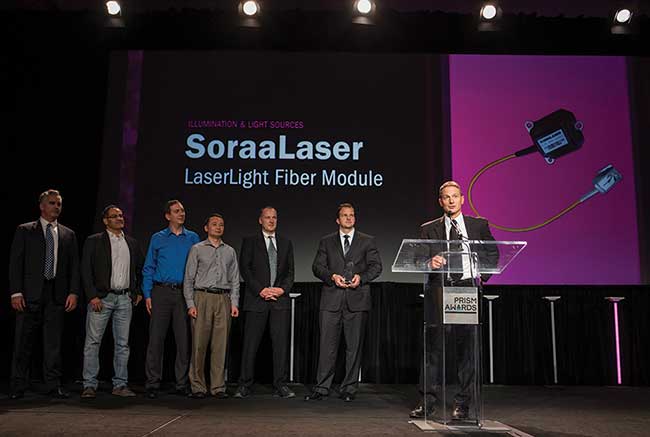
SoraaLaser, of California (U.S.), receives the Prism Award for its innovation in Illumination and Light Sources. Courtesy of SPIE.
IMAGING AND CAMERAS
Luminar (Florida, U.S.)
Addressing unmet needs for the autonomous mobility industry, the Model-G 3D LiDAR system delivers more than one million data points at full range specification per second; each point is able to detect less than 10 percent reflective targets at more than 200 m away. It simultaneously achieves 38× greater spatial resolution and 6× farther range than most existing systems. The new architecture features a single laser and detector pair to rapidly collect information from the environment while remaining eye safe. Its sensor operates at 1550 nm, which requires InGaAs. A new Si-InGaAs hybrid ASIC is involved, with an order-of-magnitude higher performance and lower cost than other InGaAs receivers. The Model-G 3D LiDAR is the first dynamically configurable system operating at 1550 nm.
LIFE SCIENCE INSTRUMENTATION
Quantumcyte (California, U.S.)
The Q1 ArraySeQ is a single-cell analysis platform for phenotypic profiling of individual cells over thousands simultaneously and can link the information to genetic data collected from each cell. This phenotypic to genotypic correlation over many thousands of cells at the same time enables new personalized treatment options for cancer and other genetic diseases.
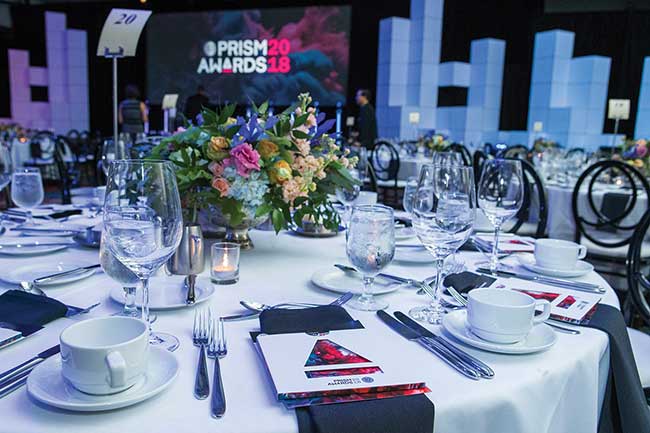
Marking its 10th year in 2018, the annual Prism Awards for Photonics Innovation highlights some the world’s top technology advancements. Courtesy of SPIE.
MEDICAL DIAGNOSTICS AND THEREAPEUTICS
ContinUse Biometrics (Tel Aviv, Israel)
Used for biomedical remote sensing, the SmartHealth Mod smartphone sensor detects nanovibrations in the body. It is the first photonic sensor capable of simultaneously monitoring several bioparameters continuously and from a distance. A smartphone add-on, it can monitor heart rate, variability and pulsewave velocity, and is the first noncontact blood pressure sensor. The SmartHealth Mod can also be used in smart homes and smart cars for home health care.
TEST AND MEASUREMENT
Spheryx Inc. (New York, U.S.)
The xSight accurately detects, counts and characterizes particle size and refractive index in the subvisible range (500 nm to 10 μm). It is the first instrument that can quickly provide quantitative measurement of size and composition in complex samples, in their native environments and in real time. In addition, the xSight can simultaneously identify and characterize similarly sized particles, and it measures them directly. The device’s high-speed analysis algorithm increases the rate of manufacturing process control.